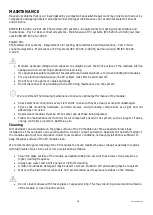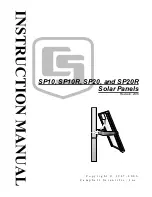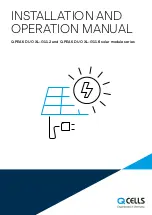
9
ANLEITUNG 04_21
PLANNING AND INSTALLATION
Intended use
•
TRIMAX PV modules are suitable for outdoor operation.
•
Ambient temperature range: -40°C to +40°C
•
Operating temperature range: -40°C to +85°.
•
Humidity: 100% and rain
•
Mechanical load capacity: snow load: 5400Pa wind load: 2400Pa
•
< 2000m altitude sea level
•
Do not expose the module to external light sources.
•
There is a risk of corrosion if the module is exposed to salt (e.g. near the sea) or sulfur sources. The
modules have passed the salt spray test according to IEC61701, but galvanic corrosion may occur
between the aluminum frame of the modules and the mounting or grounding elements if these
elements are made of different metals. The modules can be installed in coastal locations <500m, but
the components should be protected from corrosion.
•
The module should not be exposed to unusual chemical stresses.
•
Ensure that the modules are not subjected to wind or snow loads that exceed the maximum allowable
loads.
•
In regions with heavy snowfall, select the height of the mounting structure so that the lowest edge of
the module is not covered by snow and cannot be shaded by plants or trees or soiled by soil.
•
Lightning protection is recommended for PV systems that are to be installed in locations with a high
probability of lightning strikes.
Shading
The modules should not be shaded at any time. Shading leads to a
lower power output. Furthermore, systemic shading can lead to
accelerated aging and damage to the module and failure of the
system. Perform a shading analysis. Shading objects such as trees
or houses can have a significant impact on the yield prediction.
Ensure sufficient row spacing for ground-mounted systems to
avoid self-shadowing. Observe and avoid close shading by
chimneys, dormers, antenna tubes, lightning protection equipment
or overhead cables.
Consider the internal bypass diode configuration of the PV module
when selecting the orientation to ensure optimal electrical
performance against possible shading of the module.
In case of shading or soiling, in addition to the Schotky diodes, the
parallel connection of the half cells has the advantage that current
continues to flow through the unaffected string and thus 50% of
the original power still remains, but systemic shading should be
avoided to prevent permanent stress on the bypass diodes.
•
Please do not attempt to open the junction box to replace
the diode.
Figure 2: Circuit Diagram 108 CELLS- HALF-
CUT-PERC






































